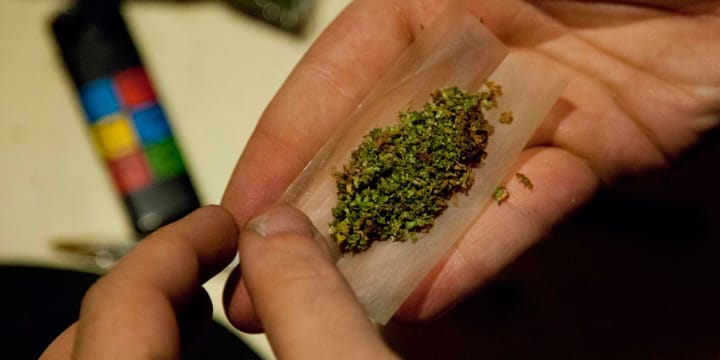Oaxacan Marijuana
Oaxacan marijuana can be hard to identify, but it provides a clean, productive, working-man's high.

During the late 20th century, a little known weed became the preferred intoxicant of millions. Stifled considerably by a criminal setting, the flow of factual information about pot was supplanted by myth and folk tradition rather than empirical evidence. Even the underground is not without its Madison Avenue counterparts. Consequently, the bottom line for the lid buyer is that his purchase is likely to be as much hype as hemp. After all, how is someone from Colby, Kansas, supposed to know with any certainty his pot is Oaxacan, Acapulco Gold, or Michoacan or that one should be better than another? There are indeed a few general guidelines, but claims that the exact origin of the marijuana can be judged by eyeballing it or some by a ritualistic smoking technique are balderdash. An experienced smoker can, however, differentiate easily between South American, Asian, or Mexican varieties, and within those varieties there are some strains that stand out for their quality.
Mexican Marijuana

Image via InfoRegion
Most cannabis consumed by Americans is Mexican pot, the best types generally coming from the southern Pacific coastal states of Michoaca, Guerro, and Oaxaca. Traditionally each state has its own distinctive crop characteristics. Oaxacan is regarded to be green, Michoacan generally medium brown, and Guerreon a yellow or golden brown. Yet, at the same time, a single plant can produce separate green, gold, and brown coletus (tops). This fact is a good reminder that there are no absolutes when it comes time to play "Name That Reefer." So the best point of view to maintain is that a name such as Acapulco Gold, which derives its name from Acapulco de Juarez, Guerro, Mexico, is a classic type of marijuana only generally indicative of the growing site. The physical appearance of marijuana is controlled by the unique combination of environmental forces on each plant.
Perhaps the most significant fact about the southern highlands is that the entire region is only a few degrees south of the Tropic of Cancer. Twice each year the sun traverses the Mexican southland between late May and early August. During that time Mother Nature cooks the terrain so severely that even the summer monsoon yields to her radiance. That's hot! The rainy season begins in June, though precipitation actually decreases by half during July when the sun is in its northernmost transit. After that period, rainfall increases again steadily from August through September, when the sun moves south and a mild autumn foretells an even dryer winter. The sun and rain on the volcanic soil of Guerreo or Oaxaca grows little else better than marijuana.
The temperature of this climate is similar to the tropical humid types, but it is distinguished by a definite dry season for four to six months during the cooler part of the year. Not entirely without rain, the dryness is sufficient to induce a seasonal rhythm in vegetation. It is actually possible to cultivate two separate crops during the year in this region.
Identifying Oaxacan Marijuana

Image via 420 Magazine
The single most effective contributor to the appearance of marijuana is water; The greener the sample, the greater the amount of water present during growth. Brown pot, on the other hand, reflects lower watering levels and higher concentration of sunlight. Remembering the characteristics of the weed grown there, northernmost Michoaca is more arid than Oaxaca and parts of Oaxaca are actually further south than Guatemala and Honduras. Traditionally, of course, the further south one goes in Mexico, the greener the pot is. There is some degree of correlation; More tropical regions do grow greener pot.
Oaxacan marijuana is the most tropical variety of mountain pot and commonly appears as all green stems and leaves—close in color. There may be some degree of brown marbling in the leaf and seed brac, usually not exceeding more than 30 percent of the foliage. The stem itself will usually not exhibit any brown at all. However, in more extreme cases, particularly with the dry season's crop, Oaxacan can take on an overall brownish-green leaf, but, still, the stem itself will maintain the green. The traditional Oaxacan color is frosty-green, with one side of the leaf being a little lighter than the other.
By comparison to Guerreon or Michoacan, the plant tends to have a thicker central trunk-stem with individual buds forming less frequently. The Oaxacan leaf tends to be the largest and broadest of various southern highland types, no matter whether the crop is cultivated for maximum intoxication or left untended to grown wild on hillside or plateau. Selectively clipping weak branches and shade leaves produces a more potent plant with more profound development of classic structure and coloring, especially on the summer crop. Proper cultivation technique mixed with intense heat, light, and humidity can grow some crazy smoke. On the other hand, wild, uncultivated Oaxacan will produce a great diversity in size and coloring of leaves on any single plant. Marbles with brown and yellow, giant coletus, as much as 18" in length, are not uncommon. Wild giants of flamboyant appearance do not make the best smoke, however. The summer giants are not common to the dryer, early spring season, when rainfall is an eighth or tenth of that which falls during the summer. Plants from this season are more likely to exhibit the brown marbling, but the pure green top and stem are never absent from these plants grown in the southernmost highlands. Distribution of foliage along the stem of dry season plants tends to be thinner than during the hot, humid tropical summer.
The Oaxacan High

Image via The Huffington Post
No matter where the growing site or what the apparent characteristics, the herb itself is cultivated to bring billows of joy to the smoker and not to be adored like a champion rose or defined in articulate essays. So put away another toke or two and give consideration to the Oaxacan high.
Among dedicated, daily smokers, Oaxacan is commonly spoken of as a working-man's smoke. Its energy-filled clean-minded high is long lasting and doesn't fatigue the body after use. Frequently preferred for daytime, Oaxacan does not leave one muddled in the style of Central and South American varieties. Not an intense body stone, the effect is nonetheless penetrating, essentially cerebral without being ethereal. The rather unique illusory quality of Oaxacan may fool the novice smoker into thinking that this southern mountain pot just doesn't get very strong. However, the best cultivated varieties will reduce even veteran smokers to a playful babbling state, though without much impairment of the individual's motor functions. Oaxacan is fun pot. So, go have some fun.
About the Creator
Potent Staff
A serious group of marijuana connoisseurs always giving back to the community. Peace.






Comments
There are no comments for this story
Be the first to respond and start the conversation.